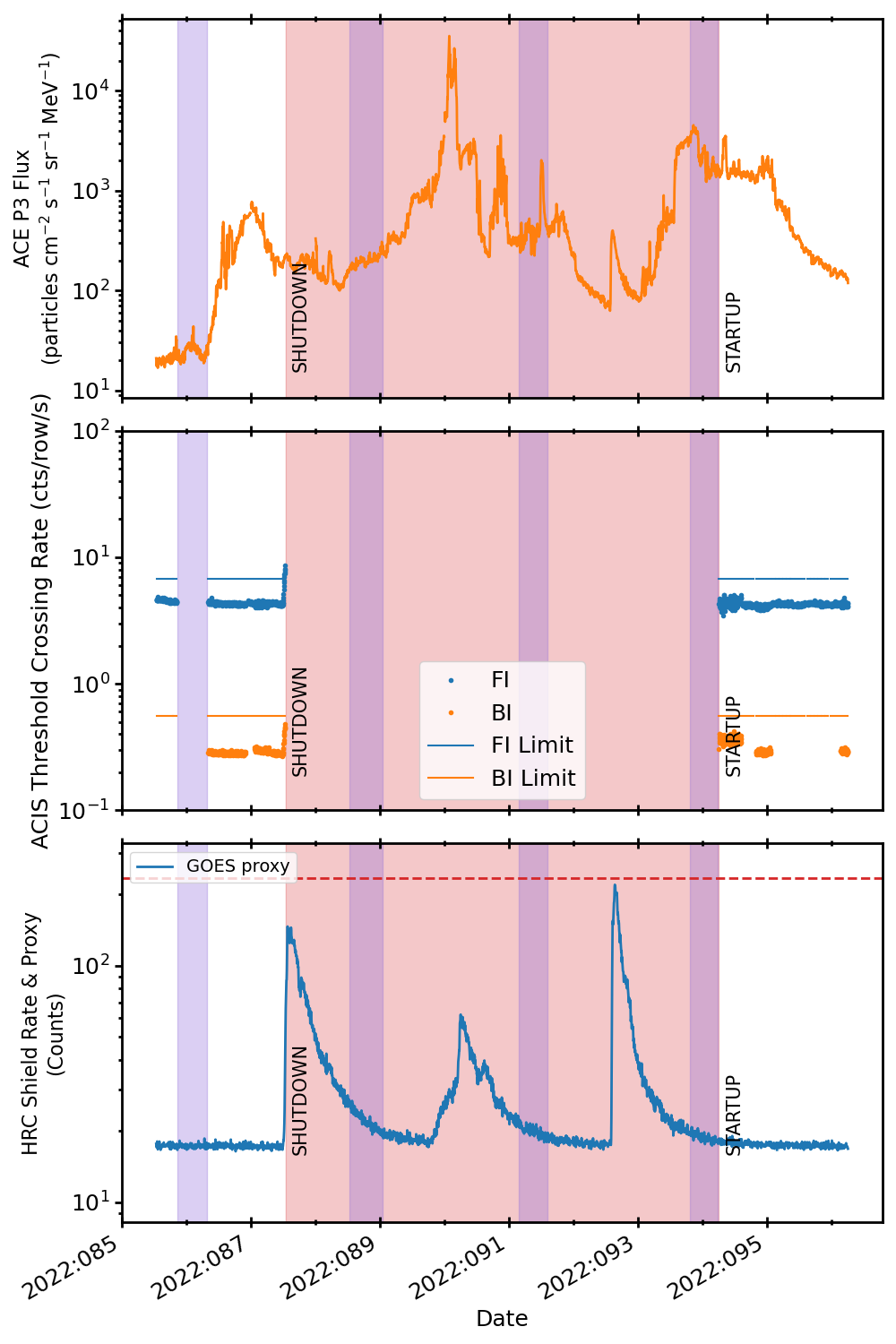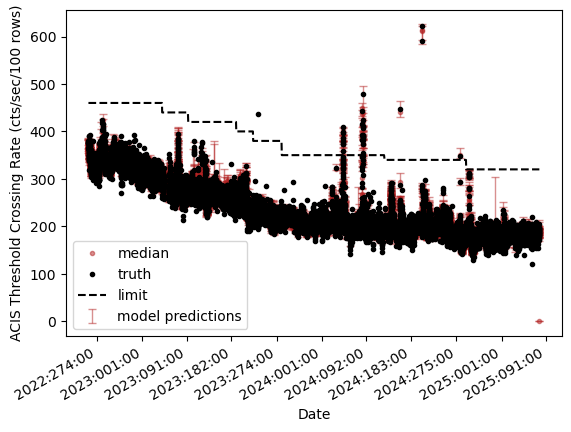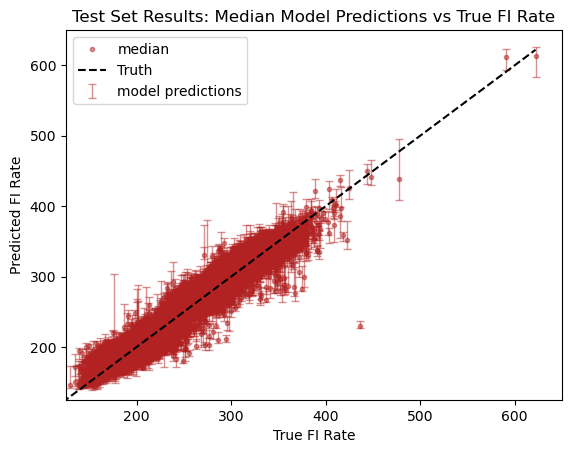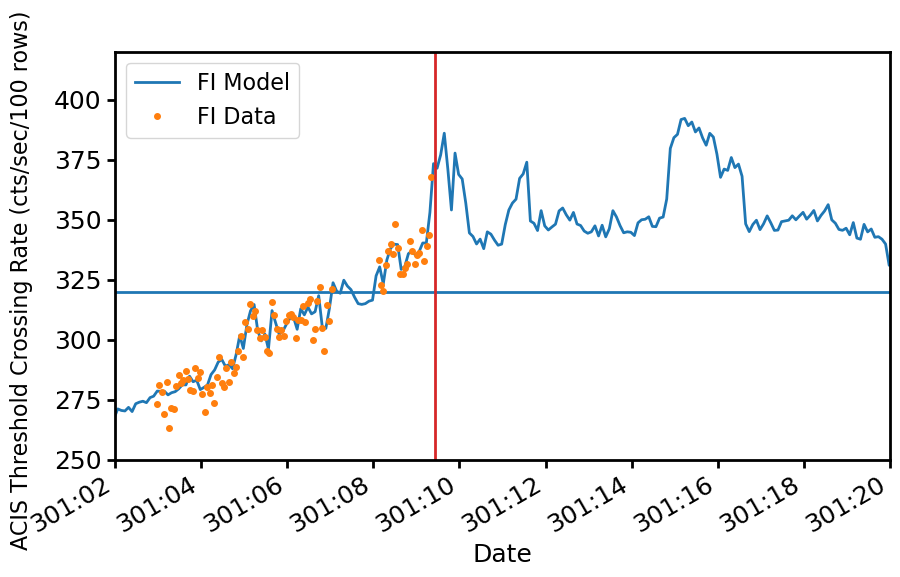ACIS Storms Analysis
protecting ACIS from space weather
Overview
The Advanced CCD Imaging Spectrometer (ACIS) camera on the Chandra spacecraft is sensitive to damage from protons in the solar wind with kinetic energies of ~100 keV, which can be reflected by the Chandra mirrors onto the CCDs and increase charge transfer inefficiency (CTI), degrading the spectral resolution of the CCDs. When solar storms occur, it is sometimes necessary to safe ACIS (shutting it down and moving it out of the focal plane) to prevent this radiation damage.
Shutdowns can be manually executed if the Chandra project judges the radiation environment to be too dangerous. There is also a mechanism for an autonomous shutdown. Earlier in the mission, Chandra used the Electron Proton Helium INstrument (EPHIN) on board to detect significant radiation levels and trigger autonomous instrument safing. EPHIN became inoperable in 2013; at this point the High Resolution Camera (HRC) anti-coincidence shield rates were used to detect solar storms. Beginning in 2020, HRC operations became reduced due to difficulties running the instrument at high temperatures, so the shield rate could no longer be used as an “always-on” radiation monitor.
The current radiation monitor aboard Chandra is the ACIS threshold crossings rate, or “txings” rate. The ACIS flight computer and software detects and recognizes X-ray events during the length of an observation. The computer examines each CCD frame to find pixels with detections above a pre-determined threshold value. Not all such events are X-rays; this is determined by further processing. However, the total txings rate is calculated and telemetered to the ground. This value is sensitive both to X-rays and to particles; because of the latter it can be used as a radiation monitor to detect solar storms and trigger autonomous safing of the science instruments.
ACIS Storm Pages
Various diagnostics of the solar wind environment are used in Chandra operations. These include:
- “Soft” protons measured by the ACE satellite; the ACE “P3” channel is the one that records the radiation that can cause significant damage to ACIS
- “Hard” protons measured by the GOES satellites
- The HRC GOES Proxy, which is a linear combination of GOES proton channels
- The ACIS txings rate, which appears to be related to the hard protons measured by GOES
For a number of solar storms, I have cataloged and plotted the behavior of these various diagnostics over time for further analysis; these plots are hosted at the ACIS Storm Pages. An example of such plots for a particular storm is shown in Figure 1 below.

ACIS txings Proxy
As mentioned above, the ACIS txings rates are currently the only solar radiation monitor on the spacecraft, and sharp rises in these rates correlate well with rises in the GOES proton data.
Motivated by this, in collaboration with my colleagues John Soltis (Johns Hopkins University) and Michelle Ntampaka (Space Telescope Science Institute), we have developed an early version of a “txings proxy” to predict the value of the txings rates during solar storms from the GOES proton data which is continuously updated in real-time. Since we only make three ~1-hour contacts with Chandra per day, and do not have real-time knowledge of the txings rates outside of these times, such a predictive proxy would be useful for two reasons: first, we can use a spike in the predicted rates to prepare for the possibility that we will come up on the next contact with the spacecraft with the likelihood that it has safed itself, and second we can use it to help decide when rates are low enough that it is safe to return to science. The txings rates are also only recorded when ACIS is taking data, so the proxy can also serve as an indicator of where the rates would be in between ACIS observations.
To produce this model, we have trained a dense neural network with PyTorch on GOES proton and txings proxy data from 2022-2025. We employ cross-validation on this data with 10 different folds which are then split into training, validation, and test data. The main measure of the model’s success is how often it correctly predicts that the txings rate will exceed the limit required to trigger a spacecraft safing action. We found that our model has an ~89% true positive rate for exceeding the limit and an ~8% false positive rate, which is more than adequate accuracy for use in real-time operations.
Figure 2 (left panel) shows the data and model predictions for the entire range of data involved in the training, validation, and testing. The right panel of Figure 2 shows the correlation between the true txings rate and the predicted rate for the test set.


Finally, Figure 3 shows the txings rates during a recent solar storm and the model prediction, which correctly predicts the rise above the limit.

Storm-related memos I have written
Any time there is a significant solar storm that causes actions to be taken by the ACIS Ops team, a memo is written. The following are memos I have written concerning some of these events.